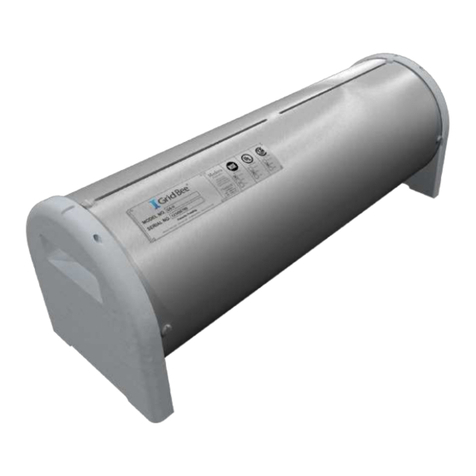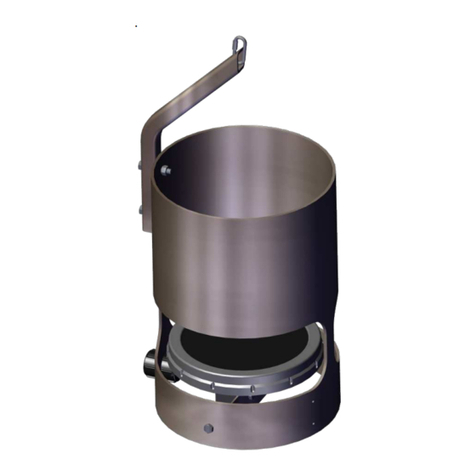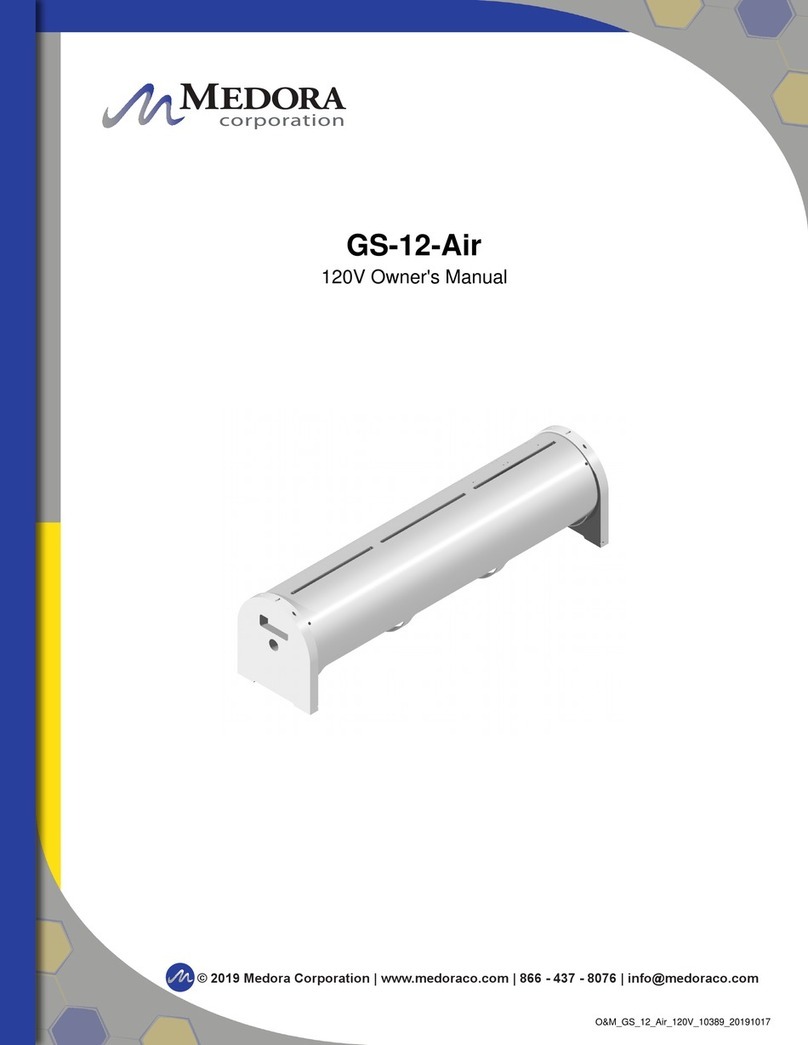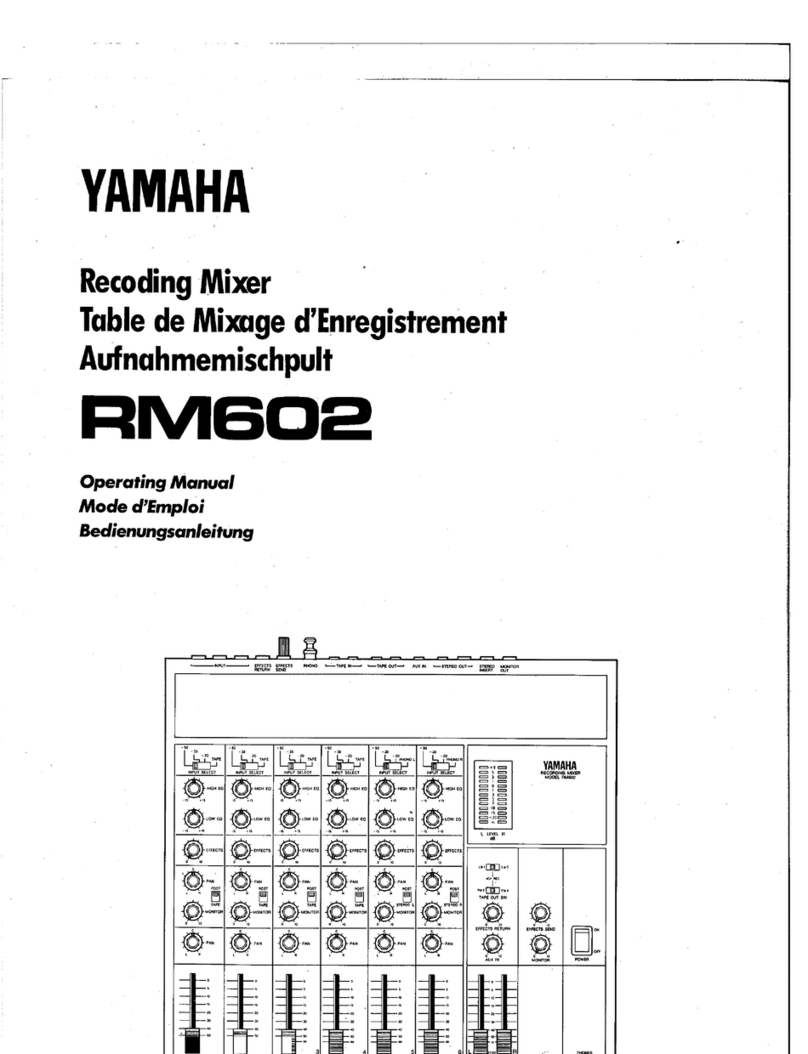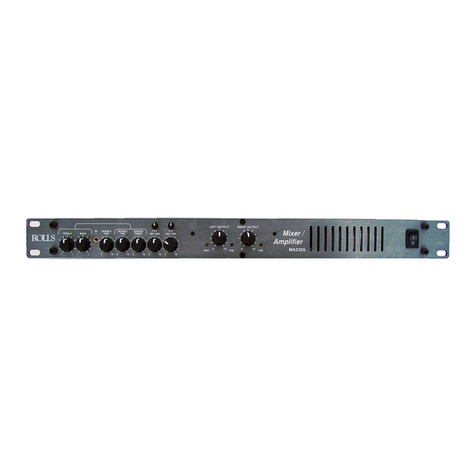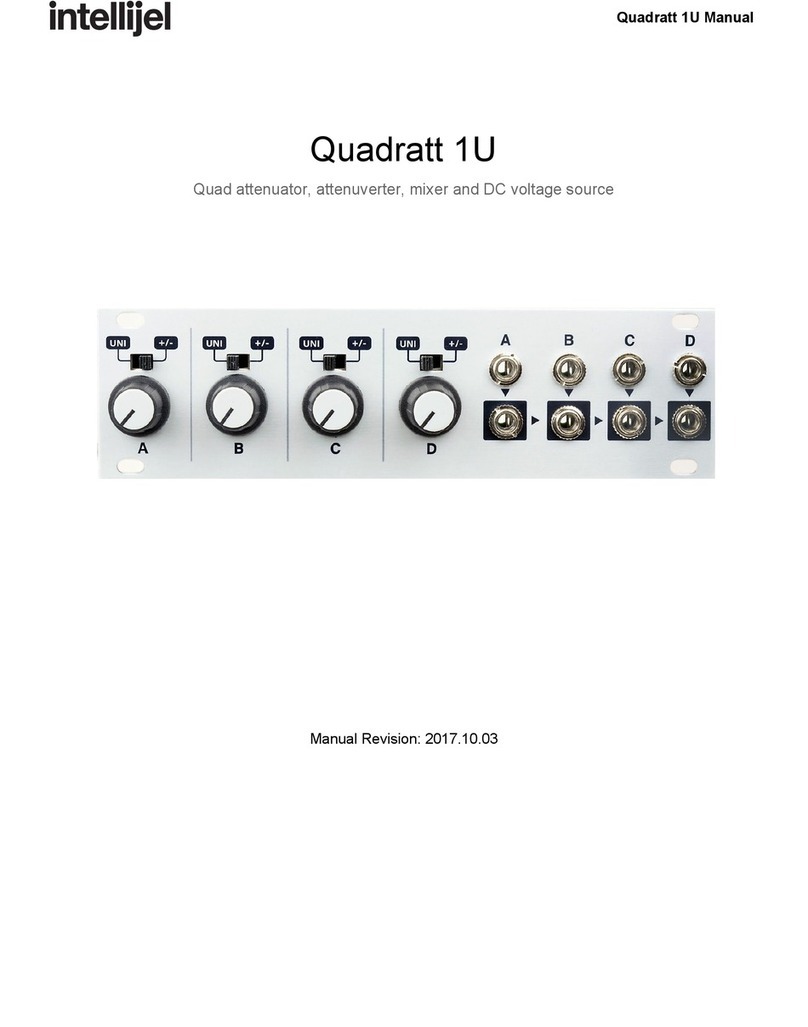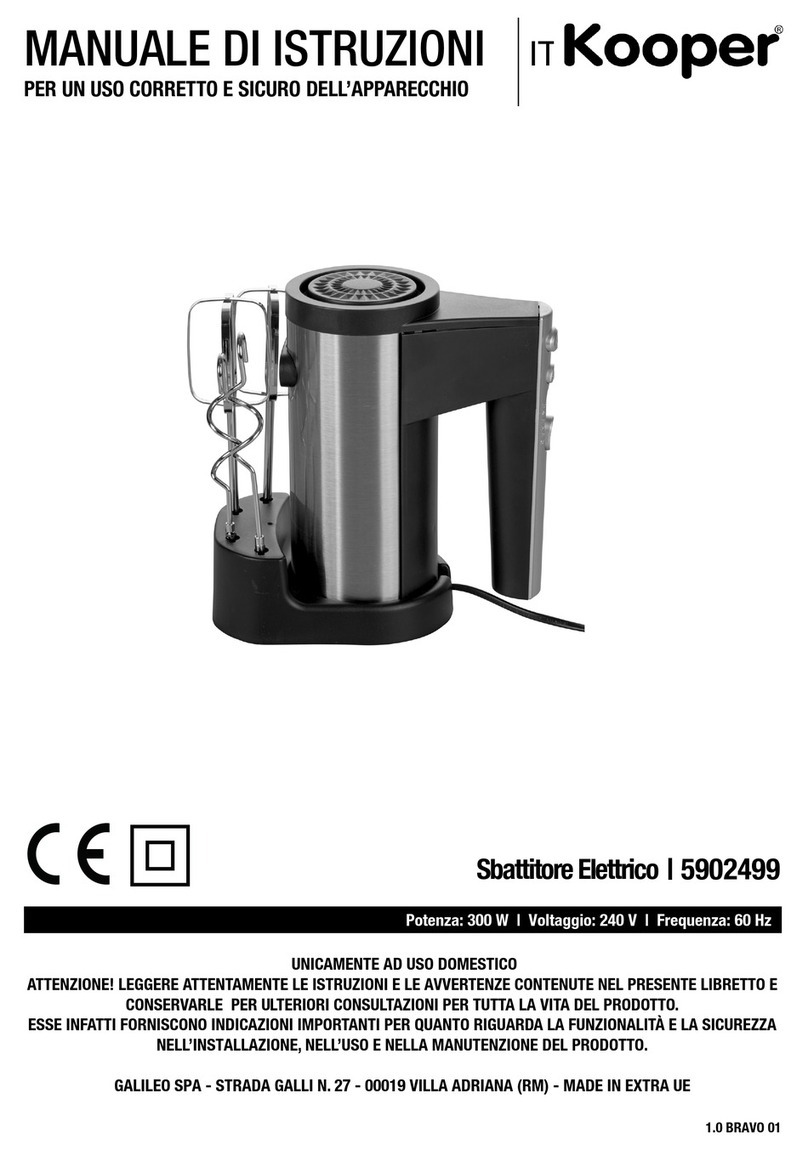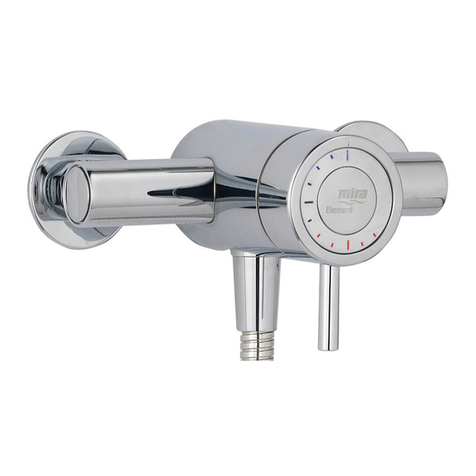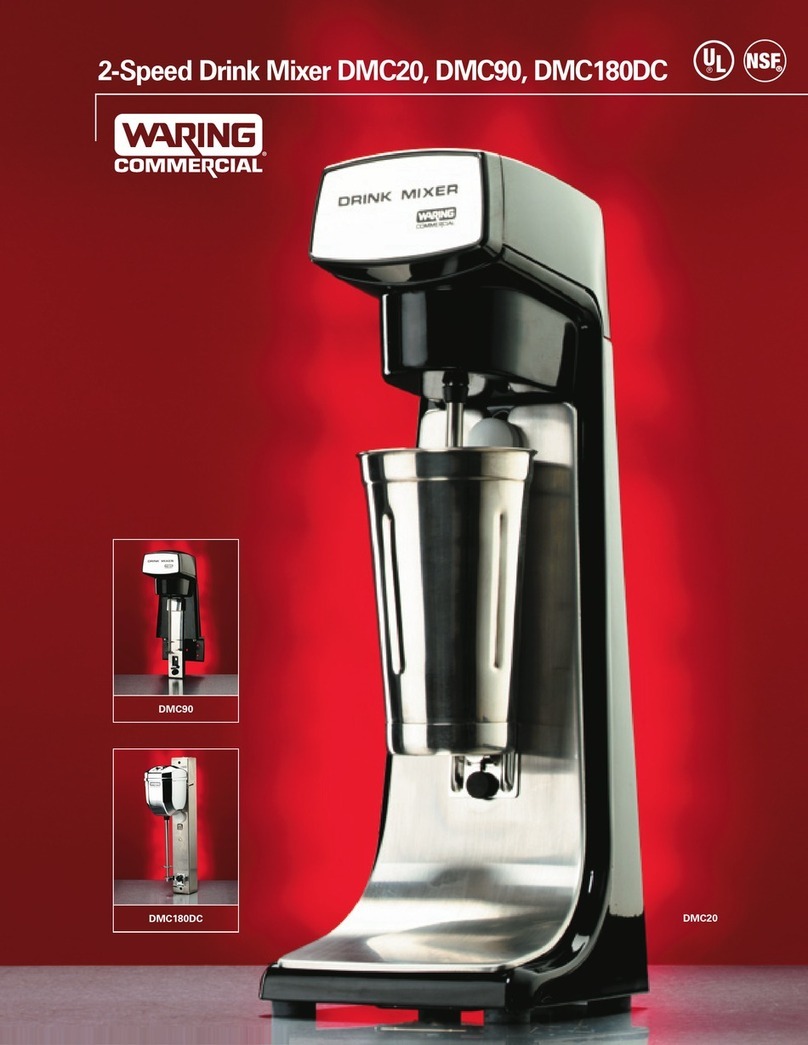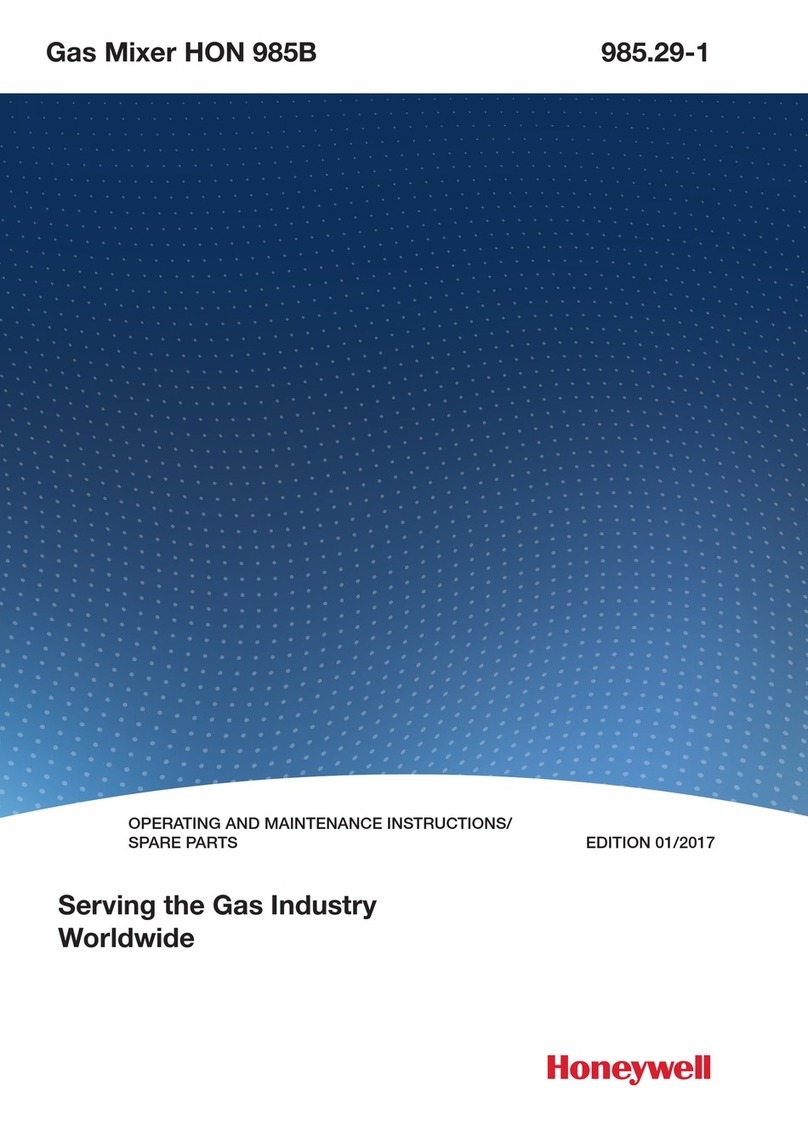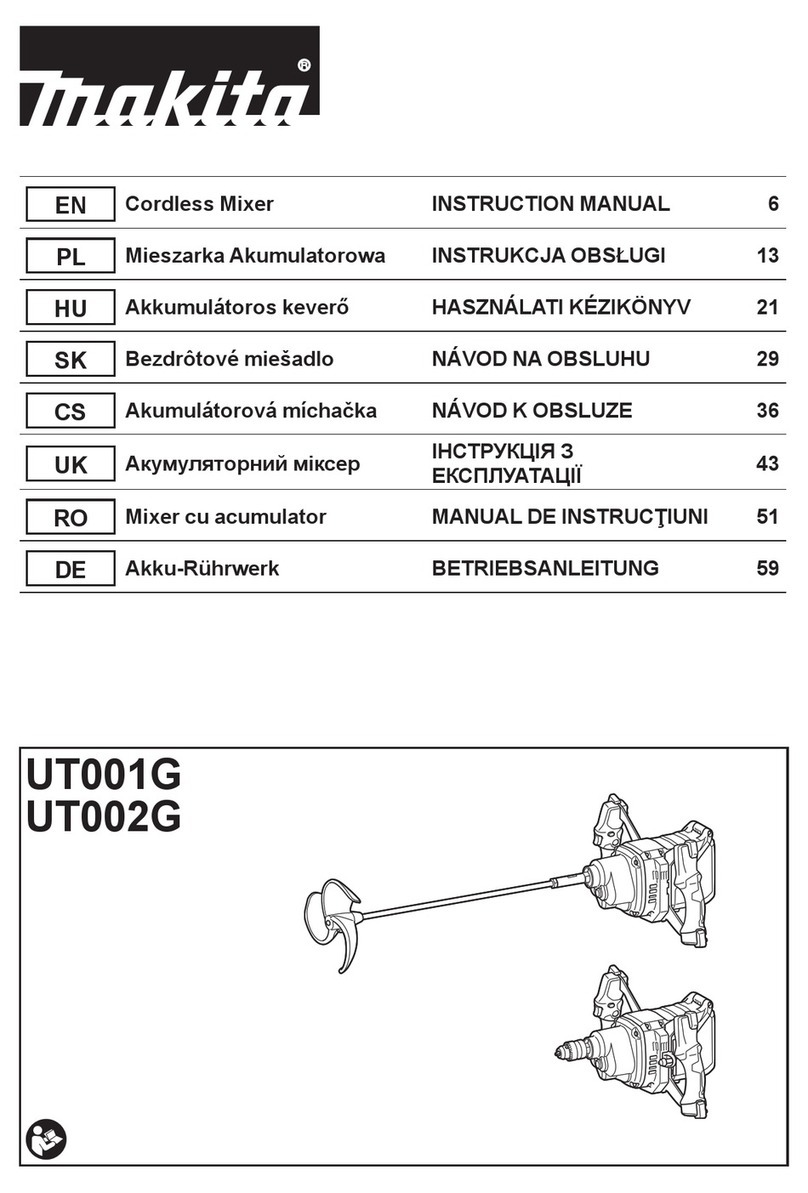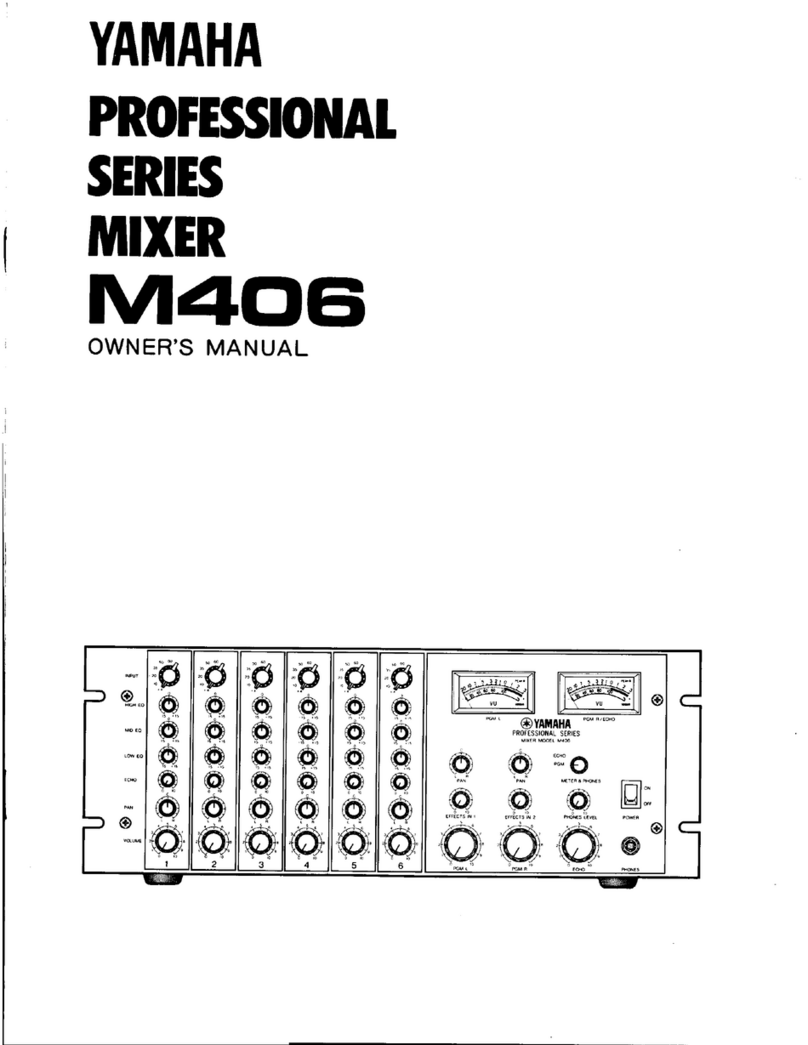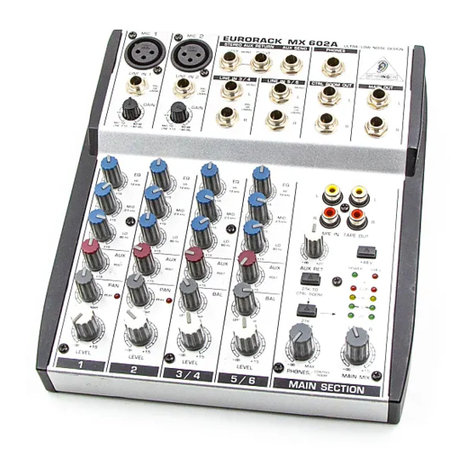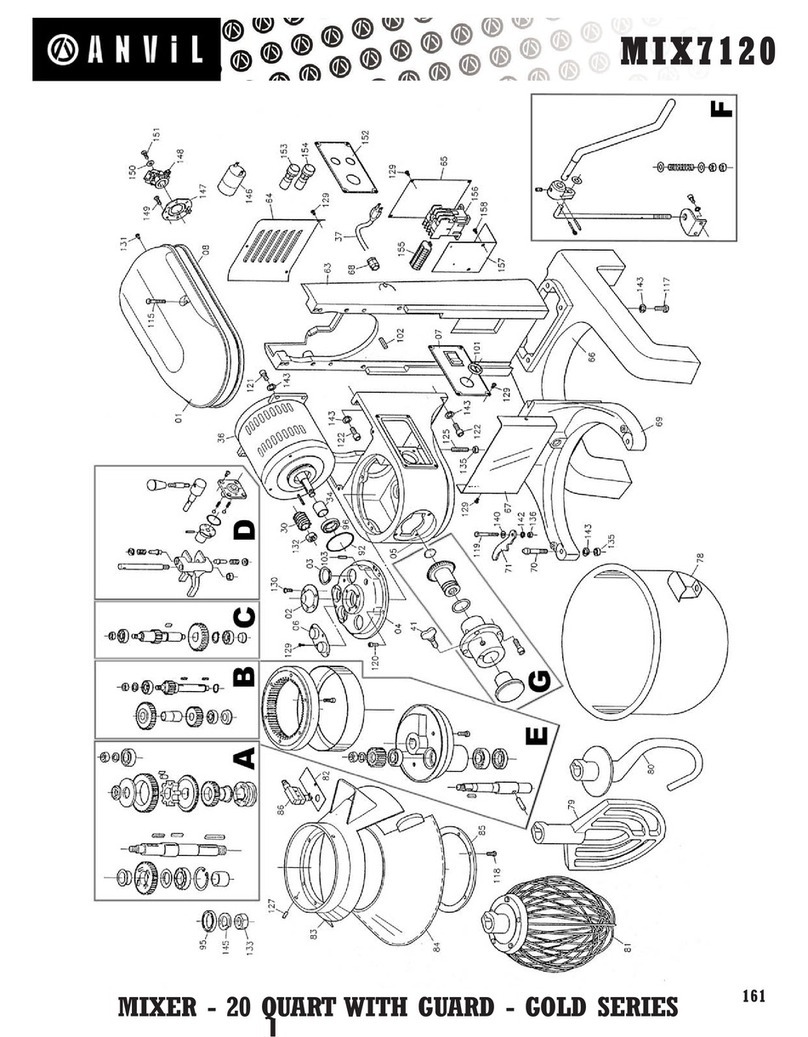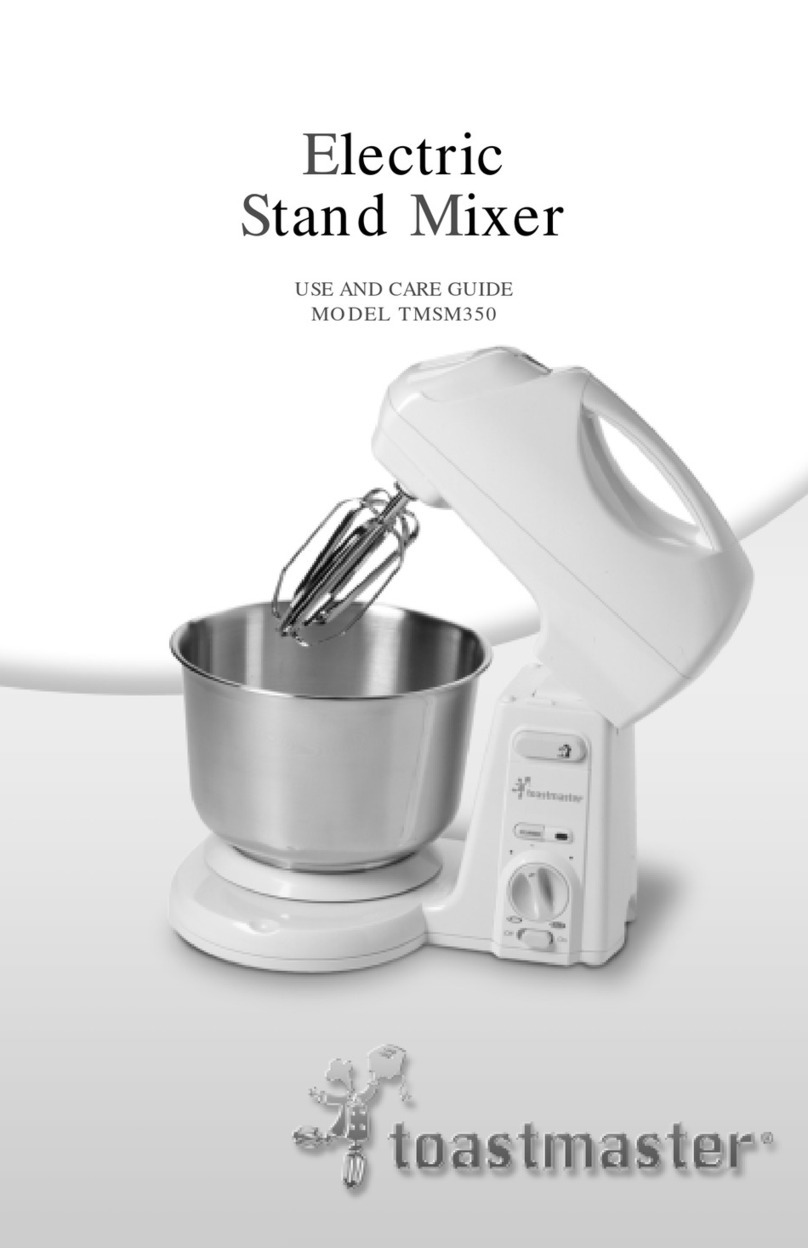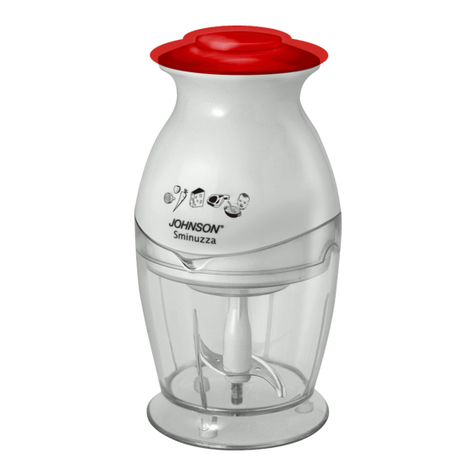Medora SolarBee SB5000 User manual

Table of Contents
About Medora Corporation
Medora Corporation combines knowledge and experience from across the water quality spectrum
to help solve real-world problems. Whether in Lakes, Stormwater Retention Ponds, Raw Drinking-
Source Reservoirs, Water Treatment Plants, Potable Storage Tanks, or Wastewater Treatment
Processes, equipment continues to be at the forefront as the #1 world
leader for in-situ water body treatment.
www.medoraco.com | 866 - 437 - 8076 | [email protected]
1910_20170390
Table of Contents
SB5000 Owner's Manual
Safety 1
Operation 4
Features 5
Maintenance 16
Electrical 28
Technical Specifications 31
Troubleshooting 32
Parts Diagram 35
Dimension Drawing 36
Warranty 37
Customer Service 38
O&M_SB5000_20181113

www.medoraco.com | 866 - 437 - 8076 | [email protected]
1949_10036_20180820
Safety
Carefully read safety information when you see
any safety symbols:
Safety
Be sure you have read all installation, operation, maintenance and safety instructions
before you install, service or begin to operate this unit.
Accidents occur every year because of careless use of industrial equipment. You can avoid
hazards by following these safety instructions, and applying some ordinary common sense
when operating or servicing this unit.
Keep in mind that full operator attention and alertness are required when operating or
servicing this unit.
USE COMMON SENSE!! Most acccidents can be avoided by using common sense and
concentration on the job being done.
O&M_SB5000_20181113 - 1

www.medoraco.com | 866 - 437 - 8076 | [email protected]
1949_10036_20180820
Safety
Identify all possible hazards. Determine what
safeguards are needed and implement them.
Only you, the user, understand your product
and system characteristics fully. The ultimate
responsibility for safety is with you. Your
safety ultimately rests in your hands. Do
your part and you will enjoy safe, trouble free
operation for years to come. This instruction
manual is not intended to include a compre-
hensive listing of all details for all procedures
required for placement, operation and mainte-
nance. If you have a question about a proce-
dure or are uncertain about any detail, Do Not
Proceed. Please contact GridBee Customer
Service at 866-437-8076 to speak to a repre-
sentative.
IMPORTANT!!!
Follow all federal and state laws in regards
to safety regulations of working at heights,
conned spaces, rescue, etc. as required by
the U.S. Department of Labor, Occupational
Safety and Health Administration. Use
necessary PPE when placing and servicing
this unit.
ELECTRICAL HAZARD
WARNING: THIS EQUIPMENT CONTAINS HIGH
VOLTAGE! ELECTRICAL SHOCK CAN CAUSE
SERIOUS OR FATAL INJURY. ONLY QUALIFIED
PERSONNEL SHOULD ATTEMPT PLACEMENT,
OPERATION AND MAINTENANCE OF
ELECTRICAL EQUIPMENT. REMOVE ALL
SOURCES OF ELECTRICAL POWER BEFORE
PERFORMING ANY SERVICE WORK TO THE
MACHINE. USE PROPER LOCKOUT TAGOUT
(LOTO) PROCEDURES TO ENSURE A SAFE
WORK ENVIRONMENT.
Rotating Hazard
CAUTION: KEEP BODY APPENANDAGES OR
LOOSE CLOTHING AWAY FROM EQUIPMENT
WHILE OPERATING. ENSURE EQUIPMENT IS
OFF BEFORE ATTEMPTING SERVICE.
Crush Hazard
WARNING: DO NOT REMOVE ANY FLOAT
ASSEMBLY BOLTS OR PINS WHILE
EQUIPMENT IS FLOATING IN WATER.
EQUIPMENT MUST BE SECURELY
SUPPORTED BEFORE PERFORMING
SERVICE.
Safety
Laceration Hazard
CAUTION: EDGES MAY BE SHARP AND
CAUSE LACERATION IF PROPER CARE IS
NOT USED.
Entanglement Hazard
WARNING: ENSURE THAT PERSONNEL ARE
CLEAR OF THE ELECTRIC CORD AND CHAIN
TO AVOID ENTANGLEMENT.
Thin Ice Hazard
WARNING: ICE SURROUNDING MACHINE
MAY NOT SUPPORT WEIGHT, KEEP CLEAR OF
THIN ICE.
O&M_SB5000_20181113 - 2

www.medoraco.com | 866 - 437 - 8076 | [email protected]
1949_10036_20180820
Safety
Safety
Permit-Required
Conned Spaces
A conned space has limited openings for
entry or exit, is large enough for entering and
working, and is not designed for continuous
worker occupancy. Conned spaces include
underground reservoirs, ground storage tanks,
elevated tanks, silos, manholes, and pipelines.
Conned Space Tips
• Do not enter permit-required conned spaces
without being trained and without having a
permit to enter.
• Review, understand and follow employer’s
procedures before entering permit-required
conned spaces and know how and when
to exit.
• Before entry, identify any physical hazards.
• Before and during entry, test and monitor for
oxygen content, ammability, toxicity or
explosive hazards as necessary.
• Use fall protection, rescue, air monitoring,
ventilation, lighting and communication
equipment according to entry procedures.
• Maintain contact at all times with a trained
attendant either visually, via phone, or by
two-way radio. This monitoring system
enables the attendant and entry supervisor
to order you to evacuate and to alert
appropriately trained rescue personnel to
rescue entrants when needed.
Refer to 29 CFR 1910.146 for complete
regulations set by OSHA. Refer to your state's
regulations if your state established and
operates their own safety and health programs
approved by OSHA.
Protect Yourself
Medora Corporation insists that you
comply with all relative OSHA and local
regulations while installing and performing
any maintenance to the mixer circulation
equipment.
Key OSHA Compliance Standards that must
be followed (and not limited to) are:
• 1910.146 Permit-required conned spaces
• 1910.147 Lockout/Tagout
• 1926.500 Fall Protection
Fall Protection Tips
• Identify all potential tripping and fall hazards
before work starts.
• Look for fall hazards such as unprotected
oor openings/edges, shafts, open hatches,
stairwells, and roof openings/edges.
• Inspect fall protection and rescue equipment
for defects before use.
• Select, wear, and use fall protection and
rescue equipment appropriate for the task.
• Secure and stabilize all ladders before
climbing.
• Never stand on the top rung/step of a ladder.
• Use handrails when you go up or down stairs.
• Practice good housekeeping. Keep cords,
welding leads and air hoses out of walkways
or adjacent work areas.
Refer to 29 CFR 1926.500 for complete
regulations set by OSHA. Refer to your state's
regulations if your state established and
operates their own safety and health programs
approved by OSHA.
Lockout Tagout
When the On/Off switch is in the "ON" position,
the mixer may start up at any time if not
already operating. The mixer's On/Off switch
can be locked out by placing a pad lock thru
the door latch of the controller after the switch
has been turned to the "OFF" position. The
On/Off switch is to be used as the emergency
stop.
O&M_SB5000_20181113 - 3

www.medoraco.com | 866 - 437 - 8076 | [email protected]
Operation
The SolarBee is designed to circulate water
by bringing water from below and sending it
out across the top in a thin layer causing a
mixing effect. The laminar layer ows outward
radially, in diverging “stream lines” from the
distribution dish. As it does, vertical ow is
induced in between the water being drawn
below and the water above. At the level of the
ow intake, water is drawn from all corners of
the pond. As this lower layer of uid makes
its way inward with converging streamlines
to the SolarBee, the water is forced upward,
toward the surface, providing gentle mixing,
de-stratication, and surface renewal.
The SolarBee obtains all the energy it needs
from the sun. Its solar panels provide power
to the onboard battery which energizes the
drive system’s controls and motor. The new
Technology allows excess solar energy to be
stored during the day and used during the
night allowing the SolarBee to operate during
the night without being connected to the grid.
During operation, a visible ow can be
observed coming off the distributor dish
and spreading outward. The impeller of the
SolarBee is designed to operate at full speed
when there is sufcient sunlight and battery
charge. The rpms may drop down some
during the later night and early morning when
the battery uses up its charge after a longer
period of overcast days. In severe sunlight
limited conditions, the machine may slow
down or stop temporarily to protect the battery
from damage.
Operation
SB Series
SolarBee Flow Pattern
10199_20180625
Flow Coming Off Distribution Dish
O&M_SB5000_20181113 - 4

www.medoraco.com | 866 - 437 - 8076 | [email protected]
Features
SB5000
10267_20181113
Features
The SolarBee with technology includes new
features which enhance its performance
through more efcient and durable components,
improved operation monitoring capablilities, easy
component access, and a robust frame structure.
Solar / Electronics
Photovoltaic (PV) Modules -The PV modules
are often referred to as the solar panels. The
SolarBee uses 100% solar energy to provide day/
night operation. The PV modules collect solar
power to operate the machine with excess left
over to charge an onboard 12-volt, deep cycle
battery. The SolarBee has 3 80-watt PV modules
which individually connect to the digital controller.
A bird deterrent is located directly above the PV
modules to prevent bird fouling.
The PV modules have 3 angle settings that
are set at the factory based on solar energy
availability unique to the customer's geographic
location. The attest position is a 35 degree
angle for customers located where solar power
availability is greatest. The mid-range setting
position is a 45 degree angle for customers where
solar power availability is moderately available.
The steepest position is a 55 degree angle
intended for winter conditions to prevent snow
and ice buildup from lasting a long time period on
the PV modules (following winter conditions, the
PV modules should be returned to their original
position to maximize solar energy collection).
55 Degree
45 Degree
35 Degree
O&M_SB5000_20181113 - 5

www.medoraco.com | 866 - 437 - 8076 | [email protected]
Features
SB5000
10267_20181113
Features
For cable tethered anchoring, the north facing
panel may be ipped to face the south using a
special panel gate. A tethered machine is xed
and will not rotate, so the north facing panel will
receive the least sunlight, unless ipped using the
special gate. For mooring block anchoring, this is
not an option due to the machine rotating about
the mooring blocks.
Each PV module is xed to a gate that opens up
allowing quick access to the interior components
of the machine. Each gate opens by simply
removing a pin on the latch end.
Onboard Battery - The onboard battery is
located directly below the dish in a stainless
steel compartment. During operation, the
battery is submerged in the water to maintain a
stable-temperature environment that increases
its performance and life. The battery is double
walled to isolate its contents from the water it is
submerged in.
The onboard battery stores excess power from
the solar panels during the day and operates the
machine using the stored power during the night
and extremely overcast days.
PV Module Gate
Hinge End
Latch
End
Battery Compartment
Onboard Battery
O&M_SB5000_20181113 - 6

www.medoraco.com | 866 - 437 - 8076 | [email protected]
10267_20181113
Digital Controller - The digital controller is
located near the top center of the SolarBee.
The digital controller can be easily accessed by
opening the PV module gate directly above and in
front of it. The digital controller is constructed with
a NEMA 4X (IP 66) Enclosure.
All solar energy collection and motor operation are
managed by the digital controller. This component
has two primary functions: (1) To direct and divide
the power being collected by the PV modules
between the brushless motor and battery. (2) To
serve as the main control center that operates the
brushless motor.
There are 3 PV module connections located
on the front face of the digital controller. If the
onshore power accessory was purchased, a
connection will be located on the right side
face. The onshore connection is used only in
applications where onshore grid power is desired.
The left side face of the digital controller
contains the brushless motor connection, battery
connection, and On/Off switch. The On/Off switch
activates power to the motor. When the switch
is turned to the Off position, the motor will not
operate. The charging function of the controller
will continue to charge the battery even when the
switch is turned off.
Front Face Of Digital Controller
Left Side Face Of Digital Controller
Features
Features
SB5000
Digital Controller
O&M_SB5000_20181113 - 7

www.medoraco.com | 866 - 437 - 8076 | [email protected]
10267_20181113
SCADA outputs offering machine operation
parameters reside within the digital controller.
Please contact Medora Corporation if you are
interested in receiving these parameters.
Motor Controller - The motor controller is located
near the motor just below the top plate of the
SolarBee. The motor controller is sealed in line
with the electrical cord that runs to the brushless
motor.
The motor controller on the SolarBee receives
power and signals from the main control center
located inside the external enlosure. These
signals are used to operate the brushless motor
at the commanded speed. The motor controller
also sends feedback signals back up to the main
control center.
Due to the high frequency of communication
between the motor controller and brushless motor,
the two components need to be located close
to one another. This is the primary reason for
having the motor controller located directly on the
SolarBee.
All electronic connections on the SolarBee
equipment should only be used for the inputs or
outputs that they are labeled and designed for. If
any of the leads going into the electronic controller
are disconnected, be sure when re-connecting to
place them in the proper position.
Wiring - All electric wiring includes corrosion-
resistant, industrial cords with molded, weather
and watertight connectors. The connectors
are indexed to prevent improper wiring. A
general electrical schematic can be found in the
Maintenance and Field Adjustment section.
Motor Control Cord
Durable Wiring And Connectors
Features
Features
SB5000
O&M_SB5000_20181113 - 8

www.medoraco.com | 866 - 437 - 8076 | [email protected]
10267_20181113
Brushless Motor / Impeller
Brushless Motor - The brushless motor is located
directly below the Top Deck. 4 bolts run down
through the Top Deck and into the housing of the
brushless motor fastening it onto the machine.
The brushless motor is built to be very durable.
The housing is constructed of casted aluminum.
The brushless motor runs very quietly and
smoothly. It does not require any maintenance. A
drive shaft extends through the bottom center of
the housing.
CAUTION: THE BRUSHLESS MOTOR WEIGHS
APPROXIMATELY 80 LBS (36 KG). DO
NOT REMOVE WITHOUT DISCUSSING THE
PROCEDURES AND EQUIPMENT NECESSARY
WITH A SOLARBEE SERVICE TEAM MEMBER.
Shaft Coupling - The shaft coupling connects
the brushless motor drive shaft to the impeller
shaft. The shaft coupling is located directly below
the brushless motor and is made up of 3 main
components. These components are called the
upper coupling, lower coupling, and coupling
sleeve. The shaft coupling is designed to allow
quick disconnect for removal of the impeller
assembly. Disconnecting the impeller shaft from
the brushless motor shaft is simply accomplished
by pulling out a pin and requires no tools. The
upper coupling remains attached to the brushless
motor while the lower coupling and coupling
sleeve remain on the impeller shaft.
Brushless Motor
Features
Features
SB5000
Upper Coupling
Lower Coupling
Coupling Sleeve
Clevis Pin
O&M_SB5000_20181113 - 9

www.medoraco.com | 866 - 437 - 8076 | [email protected]
10267_20181113
Impeller Assembly - The impeller assembly is
made up of the stainless steel impeller shaft,
stainless steel ag indicator, freeze sleeve,
stainless steel impeller blades, and plastic impeller
bushing. The impeller assembly is easily removed
by pulling a pin on the shaft coupling.
CAUTION: KEEP BODY APPENDAGES
OR LOOSE CLOTHING AWAY FROM
THE IMPELLER ASSEMBLY WHILE THE
MACHINE IS OPERATING! IF MAINTENANCE
IS REQUIRED, BE SURE TO TURN THE
SOLARBEE OFF FIRST!
The ag indicator is xed to the shaft and used as
a visual indicator of the impeller shaft's rotational
speed.
An food grade oil-lled, Teon freeze sleeve
secured with o-rings surronds the impeller shaft.
The freeze sleeve is free to rotate on the shaft. If
the water should freeze around the machine, the
freeze sleeve will stand still, frozen in by the ice,
but inside the plastic sleeve, the impeller shaft will
be turning.
The impeller blades are welded to a hub that
is securely fastened to the impeller shaft. The
impeller is designed to gently pump water from
below and can handle up to 4 inch (10 cm)
spherical solids.
The impeller bushing is a smooth collar that the
impeller shaft tip ts into. The impeller bushing
aligns and centers the impeller shaft within the
machine.
Turn SolarBee Off Before
Performing Maintenance
CAUTION
Moving blade.
Rotating parts and shaft can
cause injury.
Keep hands clear while
machine is operating.
Flag
Indicator
Impeller Blades
Impeller Hub
Freeze Sleeve
Impeller
Bushing
Block
Features
Features
SB5000
Rotating Assembly
O&M_SB5000_20181113 - 10

www.medoraco.com | 866 - 437 - 8076 | [email protected]
10267_20181113
Distributor Dish / Hose
The distributor dish, structural members, structural
fasteners, and mounting brackets are constructed
of stainless steel.
Distributor Dish - Near-laminar ow is achieved
by the SolarBee due to its uniquely designed
distributor dish. The impeller rotates while sitting
within the lower half of the distributor dish. There
are also small water passages located below the
dish to strengthen the induced ow effect (water
movement occuring between the lower water layer
entering the machine and the upper water layer
leaving the dish).
The top lip of the distributor dish is set
approximately 1 inch to 1-1/2 inch (2.5 cm to 3.8
cm) below the surface of the water to achieve best
ow results. The distributor dish depth is set by
rotating the turnbuckles located on the oat arms.
Hose / Strainer - On the SB5000 , the hose is
directly below the distributor dish and the strainer
is located at the end of the hose. The strainer
contains a buoyant oat ball inside that allows the
strainer to draw water from approximately 1.5 ft
to 2 ft (0.45 m to 0.6 m) above solid bottom. The
hose is designed to make a "J" shaped bend at
the bottom so that the strainer does not draw
sediment up from the bottom. The strainer has
a chain connected to it and can be chained up at
more shallow depths if necessary. The chain also
is used for pulling up the strainer to check it for
plugging.
SB5000 Hose and Strainer Conguration
Distributor Dish
Features
Features
SB5000
O&M_SB5000_20181113 - 11

www.medoraco.com | 866 - 437 - 8076 | [email protected]
10267_20181113
Float Arms / Floats
The SolarBee contains 3 oat arms and 3 oats.
The oat arms allow vertical positioning of the
machine and the oats provide buoyancy.
Float Arms - The oat arms are constructed of
stainless steel components. They connect the
oats to the central machine structure. Each oat
arm has a sturdy turnbuckle. The turnbuckles can
easily be rotated to adjust the vertical height of
the distributor dish. Lengthening the turnbuckle
(rotating clockwise) will raise the lip of the
distributor dish, whereas shortening the turnbuckle
(rotating counter-clockwise) will cause the lip of
the distributor dish to lower.
The turnbuckle and oat arm structure
components are constructed with robust stainless
steel materials allowing the SolarBee to operate
in severe environments without being damaged.
The turnbuckle is self locking. Simply rotate the
handle to expand or collapse the turnbuckle for
dish depth adjustment.
It is important to check the distributor dish depth
routinely. The SolarBee naturally drops into
the water over time due to biomass buildup
and trapped air escaping from the hose. If the
distributor dish lip is too high, the water coming off
the lip may become turbulent and the ow rate of
the machine may be reduced.
Features
Features
SB5000
Turnbuckle
Float Arm
Handle
1 inch to 1-1/2 inch (2.5 cm to 3.8 cm)
Distance Between Distributor
Dish And Water Level
O&M_SB5000_20181113 - 12

www.medoraco.com | 866 - 437 - 8076 | [email protected]
10267_20181113
If the distributor dish lip is too low, the water
coming off the lip will ow just underneath the
surface of the pond and the surface will not be
renewed.
Each oat arm is connected to the central
machine structure with 1 bolt and 1 pin. Each
oat is connected to the oat arm by 2 pins. The
turnbuckle can be removed from the oat arm by
pulling a pin, but should only be done when the
unit is resting on the shore.
If re-attaching the turnbuckle to the oat arm, be
sure that each threaded end of the turnbuckle
together are screwed all the way in or all the way
out before re-attaching. If threaded ends are not
equally expanded or collapsed before xing the
ends, the turnbuckle will have limited adjustment.
Floats - The SolarBee has 3 oats, made from
high density Polyethylene. The oats are lled
with a Polystyrene closed-cell foam for long term
buoyancy. The oats have a uniquely designed
shape to:
• Minimize the interference with the water
ow on the surface coming off the
distributor dish.
• Have a low prole above the water for
minimizing wind resistance and
offering less exposure to vandalism.
• Avoid being crushed by ice pressure.
• Provide extra buoyancy when needed
without going much deeper into the
water.
Features
Features
SB5000
Float Arm Connection Points
Pin
Pin
Pin
Pin
Float
CAUTION: DO NOT REMOVE
ANY FLOAT ASSEMBLY
PINS OR BOLTS WHILE THE
SOLARBEE IS FLOATING IN
THE WATER! THE SOLARBEE
MUST BE RESTING ON
THE GROUND OR SAFELY
SUPPORTED TO RELIEVE
THE FORCES ON THE FLOAT
ASSEMBLY STRUCTURES
PRIOR TO DISASSEMBLY!
FAILURE TO FOLLOW THIS
WARNING COULD LEAD TO
SINKING THE SOLARBEE,
SERIOUS INJURY!
O&M_SB5000_20181113 - 13

www.medoraco.com | 866 - 437 - 8076 | [email protected]
10267_20181113
Anchoring Systems
The SolarBee uses one of the following anchoring
systems. The mooring block system consists
of submerged anchors and doesn't require lines
running from the shoreline. The tethering system
uses cable that spans across the pond or reservoir
connecting to tethering posts on the shorline.
Mooring Block System - The mooring block
system consists of two mooring blocks made of
high density Polyethylene with smooth, rounded
bottoms. The smooth bottoms prevent any
damage being done to a pond liner or reservoir
bottom. The mooring blocks are concrete lled
and weigh approximately 70 lbs. (32 kg).
Stainless steel anchor chain is used to connect
the mooring blocks to the SolarBee at the oat
plate on one of the oats. The anchor chain
contains swivels approximately every 15 ft (4.5 m)
to prevent the chain from twisting and tangling.
A 7:1 scope is generally preferred for the length
of anchor chain. For example, if the pond is
approximatley 10 ft (3 m) deep, the anchor chain
will go from the rst mooring block out 70 ft (21
m) to the machine. The 7:1 scope prevents the
machine from moving during high wind and wave
conditions. The two mooring blocks are generally
spaced apart along the anchor chain by a distance
approximately the depth of the water. From time
to time, as determined by specic circumstances,
the scope can be reduced to 5:1.
Features
Features
SB5000
Movement of machine - For a SolarBee
anchored by a mooring block system, the
machine may rotate 360 degrees around the
mooring blocks on a radius of approximately
5X to 7X the water depth. For example, a
machine that is in 10 ft (3 m) of water may
travel on a 70 ft (21 m) radius from the
location of the mooring blocks.
Mooring Blocks
Mooring Block System (7:1 Scope)
O&M_SB5000_20181113 - 14

www.medoraco.com | 866 - 437 - 8076 | [email protected]
10267_20181113
Following severe weather conditions (greater than
80 mph (129 km/hr) wind, higher than 4 ft (1.2 m)
waves, or ice thaw), it is possible for the SolarBee
to drag the anchors and move out of position. If
this should happen, the pond or reservoir operator
will need to re-locate the machine to its original
position.
WARNING: IF MOVING OR DEPLOYING
MOORING BLOCKS CONNECTED TO THE
ANCHOR CHAIN, BE SURE THAT YOU AND
OTHERS ARE CLEAR OF THE ANCHOR CHAIN
BEFORE SINKING THE MOORING BLOCKS!
LOWER THE MOORING BLOCKS INTO THE
WATER SLOWLY. FAILURE TO DO SO COULD
CAUSE SERIOUS INJURY OR DEATH BY
DROWNING!
Tethering System - The tethering system
constists of 2 tether posts or duckbill anchors set
into the shoreline across from one another. A
stainless steel cable is strung across the pond
or reservoir and tied to both tether posts. The
SolarBee has 2 short chains running from two of
the oat plates on the machine out to the cable
line running across the pond or reservoir.
The tethering system is used in applications where
the body of water is very narrow or the Mooring
Block System is not applicable. Following severe
weather conditions (greater than 80 mph (129
km/hr) wind, higher than 4 ft (1.2 m) waves, or
ice thaw), it is possible for the tether posts to pull
partly or completely out of the ground. If this
should happen, the pond or reservoir operator
will need to re-locate the machine to its original
position.
Features
Features
SB5000
Tethering System
Movement of machine - For a SolarBee
anchored by a tether system, the machine
will have limited movement, however slack
will be left to allow for water uctuation. The
tether line slack will be eld determined
based on tether line span and expected water
uctuation. The SolarBee will not rotate when
it is anchored using the tether system.
O&M_SB5000_20181113 - 15

www.medoraco.com | 866 - 437 - 8076 | [email protected]
Maintenance and Field Adjustment
SB5000
10268_20181113
The performance of the SolarBee has proven
to increase tremendously when its operator
understands the operation of the machine
and knows how to carry out eld adjustment
procedures.
In most applications, it is strongly encouraged
that the operator have a boat to perform routine
checkups and eld adjustment procedures on the
SolarBee. A large, expensive boat isn't necessary.
Our SolarBee eld teams use 12 ft (3.65 m) Jon
boats that work ne for almost all applications.
It is extremely important that safety comes rst
every time the SolarBee is inspected or having
maintenance procedures performed. It is strongly
encouraged that anyone working on or near the
machine follow these rules:
Wear a personal oatation device
Stay focused and alert
Turn the SolarBee off before working on it
Stay clear of parts while they are moving
To turn the SolarBee motor off, turn the On / Off
switch to the off position. To completely power
down the digital controller, remove all power
sources in the proper sequence.
Maintenance
ON / OFF
SWITCH
DIGITAL
CONTROLLER
O&M_SB5000_20181113 - 16

www.medoraco.com | 866 - 437 - 8076 | [email protected]
Maintenance and Field Adjustment
SB5000
10268_20181113
PV Module Cleaning
The solar panels are the SolarBee's primary
source of energy, so it is important that they be
kept clean. Over time, dust collects on the PV
modules or birds are not kept completely off by
the bird deterrent resulting in the panel's effective
surface area decreasing.
TOOLS RECOMMENDED:
Squeegee
Glass Cleaner
Paper Towel or Wash Cloth
STEP 1: Rinse panel face off with water.
STEP 2: Use squeegee, towel, or wash cloth to
clean surface of panel.
STEP 3: Remove any streaks or lms using glass
cleaner and paper towel/wash cloth.
STEP 4: Repeat Steps 1 through 3 for each solar
panel.
Maintenance
O&M_SB5000_20181113 - 17

www.medoraco.com | 866 - 437 - 8076 | [email protected]
Maintenance and Field Adjustment
SB5000
10268_20181113
Maintenance
Solar Panel Angle Adjustment
The SolarBee technology includes tilting PV
modules to allow for optimal solar collection for
different geographical regions and changing sun
position during the seasons.
Use 35 Degree (Flattest Position):
Where - Locations south of 40 degree latitude.
When - During fall, summer, and spring or year
round if no adjustment is preferred.
OR
Where - Locations north of 40 degree latitude.
When - During summer only.
Use 45 Degree (Middle Position):
Where - Locations north of 40 degree latitude
(Especially Great Lakes Region and Canada).
When - During spring and fall or year round if no
adjustment is preferred.
OR
Where - Locations south of 40 degree latitude.
When - During winter
Use 55 Degree (Steepest Position):
Where - Locations north of 40 degree latitude.
When - During winter season or periods of
abundant snow (The steep angle will help prevent
snow from building up on the panels).
TOOLS RECOMMENDED:
Two 1/2" or 13 mm wrenches
STEP 1: Loosen 2 bolts on each end of the PV
module using 1/2" or 13 mm wrenches as shown
in the gure below.
Bolts
STEP 2: Firmly grip the PV module and slide
it up or down the tracks until it is in the desired
position. For each of the three recommended
angle settings listed, there is a slot in the top
tracks at both ends that the top bolt will drop into.
STEP 3: Once the PV module is in the desired
position, tighten all four bolts.
STEP 4: Repeat steps 1 through 3 for other two
solar panels
Bolts
O&M_SB5000_20181113 - 18
Table of contents
Other Medora Mixer manuals

